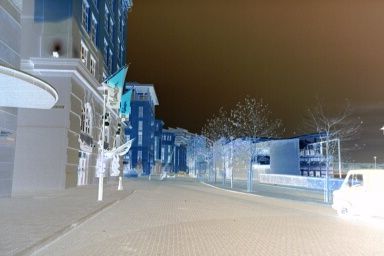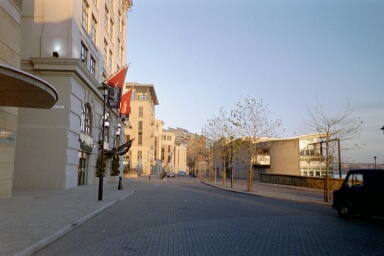

The film is the bit where the real chemistry lies. A photographic film is basically a suspension of silver halide 'grains' (crystals) in a gelatin matrix. This gelatin matrix is melted and applied to a polymer base that holds the film together. The light sensitivity of this silver halide suspension is brought about by the following photo-dissociation reaction:
Ag+Br- (crystal) + hv (photon of light) ® Ag+ + Br + e-
The silver ion can then combine with the electron:
Ag+ + e- ® Ag
Giving a free silver atom. Association within the grains produces species up to Ag4.
This free silver on the film appears as darkness where the light has been. The most light produces the darkest patch, there is an inverse relationship between the two, hence the image produced on the film is a NEGATIVE. The negative on the left below produces the picture on the right when developed.


Notice that the darkest part of the picture (the van on the right) is the lightest part of the negative, since very little photons came from that part of the picture to dissociate the silver halide in that part of the frame.
Film comes in different sensitivities. These are given as ISO numbers (100,200,400 etc.) The higher the number, the more sensitive the film is ( ISO 200 film needs only half as much exposure as ISO 100 film to achieve correct exposure). However, the increase in sensitivity is achieved by using bigger crystals of silver halide (as well as different compositions of silver halide), which reduces the fine detail available in the picture. Therefore very 'fast' films like ISO 3200 should only be used where speed is of importance as the resulting image will be grainy compared with a ISO 100 film.
In order to develop the film, the number of free silver atoms in each grain needs to be increased in order to magnify the effect of the negative on the film. In order to do this, a developer needs to be chosen that will reduce the grains containing silver nuclei much faster than those that do not, otherwise the image will be 'fogged'. Such developers used could be p-Dihydroxybenzene or p-Aminophenol.
Once the desired level of development has been achieved and in order to halt the process quickly, a 'stop bath' is used (usually just a bath of weak acid) that halts the development process rapidly by changing the pH to one unfavourable for the development reaction.
In order that no more silver halide ions are converted into silver by light after development has taken place, it is important to 'fix' the film using sodium thiosulphate (hypo), which turns the insoluble silver iodide ions into easily soluble complexes that can be washed off of the film. Full details of the development process can be found at: http://www.cheresources.com/photochem.shtml.
It is now possible, using the 'fixed' negative, to shine light through the negative onto light sensitive paper and obtain a print of the photograph!